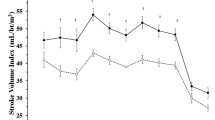Abstract
Changes in body core temperature (T cor) and heat balance after an abrupt release of lower body negative pressure (LBNP) were investigated in 5 volunteers under the following conditions: (1) an ambient temperature (T a) of 20 °C or (2) 35 °C, and (3)T a of 25 °C with a leg skin temperature of 30°C or (4) 35°C. The leg skin temperature was controlled with water perfusion devices wound around the legs. Rectal (T re), tympanic (T ty) and esophageal (T es) temperatures, skin temperatures (7 sites) and oxygen consumption were measured. The intensity of LBNP was adjusted so that the amount of blood pooled in the legs was the same under all conditions. When a thermal balance was attained during LBNP, application of LBNP was suddenly halted. The skin temperatures increased significantly after the release of LBNP under all conditions, while oxygen consumption hardly changed. The release of LBNP caused significant falls inT cor s under conditions (1) and (3), but loweredT cor s very slightly under conditions (2) and (4). The changes inT es were always more rapid and greater than those ofT ty andT re. The falls inT ty andT re appeared to be explained by changes in heat balance, whereas the sharp drop ofT es could not be explained especially during the first 8 min after the release of LBNP. The results suggest that a fall inT cor after a release of LBNP is attributed to an increase in heat loss due to reflexive skin vasodilation and is dependent on the temperature of venous blood returning from the lower body. It is presumed thatT es may not be an appropriate indicator forT cor when venous return changes rapidly.
Similar content being viewed by others
References
Brinnel H, Cabanac M (1989) Tympanic temperature is a core temperature in humans. J Therm Biol 14:47–53
Carlsten A, Grimby G (1958) Rapid changes in human right heart blood temperature at variations in venous return. Scand J Clin Lab Invest 10:397–401
Collins KJ, Easton JC, Exton-Smith AN (1982) Body temperature afterdrop: a physical or physiological phenomenon? J Physiol 277:72–73
Cranston WI, Gerbrandy J, Snell ES (1954) Oral, rectal and oesophageal temperatures and some factors affecting them in man. J Physiol 126:347–358
Dawson CA, Roemer RB, Horvath SM (1970) Body temperature and oxygen uptake in warm- and cold-adapted rats during swimming. J Appl Physiol 29:150–154
Fagius J, Kay R (1991) Low ambient temperature increases baroreflex-governed sympathetic outflow to muscle vessels in humans. Acta Physiol Scand 142:201–209
Hirata K, Nagasaka T, Hirai A, Hirashita M, Takahata T, Nunomura T (1986) Effects of human menstrual cycle on thermoregulatory vasodilation during exercise. Eur J Appl Physiol 54:559–565
Honda N (1962) Temperature compensation for mercury strain gauge used in plethysmography. J Appl Physiol 17:572–574
Kleitman N, Doktorsky A (1933) Studies on the physiology of sleep. VII. The effect of the position of the body and of sleep on rectal temperature in man. Am J Physiol 104:340–343
Mekjavić IB, Bligh J (1989) Core threshold temperatures for sweating. Can J Physiol Pharmacol 67:1038–1044
Mittleman KD, Mekjavić IB (1988) Effect of occluded venous return on core temperature during cold water immersion. J Appl Physiol 65:2709–2713
Nadel ER (1979) Temperature regulation. In: Strauss RH (ed) Sports medicine and physiology. Saunders, Philadelphia, pp 130–146
Sagawa S, Shiraki K, Miki K, Tajima F (1993) Cardiovascular responses to upright tilt at a simulated altitude of 3,700 m in men. Aviat Space Environ Med 64:219–223
Shiraki K, Sagawa S, Yousef MK, Konda N, Miki K (1987) Physiological responses of aged men to head-up tilt during heat exposure. J Appl Physiol 63:576–581
Tanabe M, Sakurada S, Shido O, Nagasaka T (1990) Cardiovascular responses to low levels of lower body negative pressure in athletes and nonathletes. Jpn J Aerospace Environ Med 27:67–73
Tepper RH, Hellebrandt FA (1938) The influence of the upright posture on the metabolic rate. Am J Physiol 122:563–568
Wenger CB, Roberts MF, Stolwijk JAJ, Nadel ER (1975) Forearm blood flow during body temperature transients produced by leg exercise. J Appl Physiol 38:58–63
Whitney RJ (1953) The measurement of volume changes in human limbs. J Physiol 121:1–27
Zoller RP, Mark AL, Abboud FM, Schmid PG, Heistad DD (1972) The role of low pressure baroreceptors in reflex vasoconstrictor responses in man. J Clin Invest 51:2967–2972
Author information
Authors and Affiliations
Rights and permissions
About this article
Cite this article
Tanabe, M., Shido, O. Changes in body core temperatures and heat balance after an abrupt release of lower body negative pressure in humans. Int J Biometeorol 38, 48–54 (1994). https://doi.org/10.1007/BF01241805
Received:
Revised:
Accepted:
Issue Date:
DOI: https://doi.org/10.1007/BF01241805




